The University of Exeter saw the Russell Group as a "more natural fit" after the government's AAB policy "changed the debate", its vice-chancellor said, as four additional institutions joined the elite mission group.
Sir Steve Smith made the comments after it was announced that Exeter, Durham University, the University of York and Queen Mary, University of London - all previously members of the 1994 Group - had joined the set of larger research-intensive universities.
The 1994 Group, which represents smaller research-led institutions, is said to have been given only half an hour's notice of the universities' decision to leave prior to the issuing of a press release by the Russell Group announcing the new members.
Reportedly there had been a split within the 1994 Group over whether it should offer a public defence of widening access in higher education following the furore over the government's appointment of Les Ebdon, the vice-chancellor of the University of Bedfordshire, as the next director of fair access.
Sir Steve, a former chair of the 1994 Group, said the organisation "has been fantastically strong and successful", but added that the "sector is changing".
"The view at Exeter was that we see ourselves as more of a Russell Group profile, certainly in terms of research strength, but also in terms of admissions," he said.
Last year, the government announced that universities would be allowed unlimited recruitment of students with A-level grades of AAB or better in 2012-13. Institutions with a high proportion of such students will benefit as they will be protected from cuts to undergraduate places.
Exeter, Durham and the University of Bath were the only non-Russell Group universities in the top 10 institutions with the highest proportion of AAB students, calculated on the basis of 2009-10 data published by the Higher Education Funding Council for England last year (see table above).
Sir Steve, who was Universities UK president at the time the AAB policy was developed, said: "The AAB thing changed the debate."
He added: "Durham and ourselves were up there and then York was a little bit lower, but not much."
The new members may put added pressure on Russell Group universities with lower proportions of high-achieving students. Although Queen Mary figures lower down the table for the proportion of AAB students, it scored highly in the 2008 research assessment exercise.
Michael Farthing, chair of the 1994 Group and vice-chancellor of the University of Sussex, is said to have pressed for a public assertion of the group's commitment to widening access following press criticism of Professor Ebdon's appointment.
But some within the sector believe that the group was held back from delivering such a statement at a late stage by a number of member institutions.
The departures leave the 1994 Group with 15 members, while the Russell Group now has 24.
Register to continue
Why register?
- Registration is free and only takes a moment
- Once registered, you can read 3 articles a month
- Sign up for our newsletter
Subscribe
Or subscribe for unlimited access to:
- Unlimited access to news, views, insights & reviews
- Digital editions
- Digital access to THE’s university and college rankings analysis
Already registered or a current subscriber? Login
